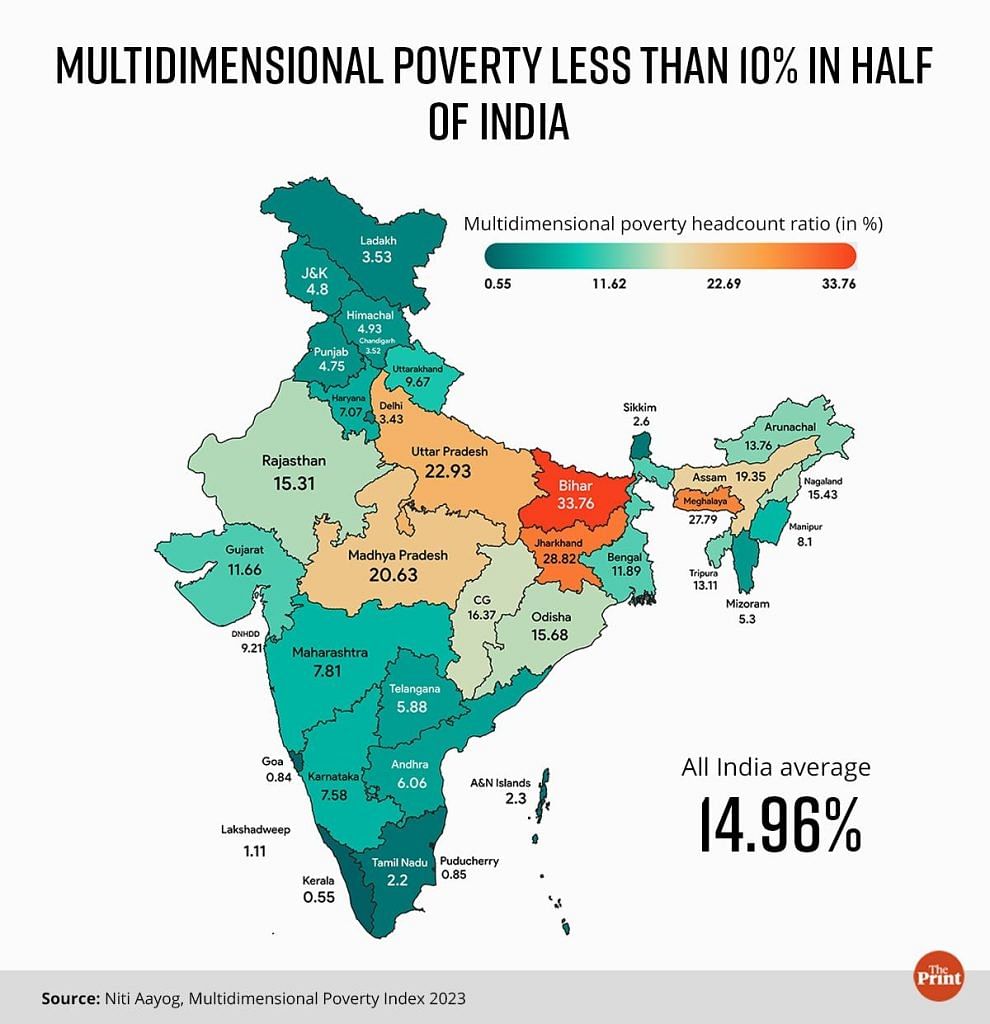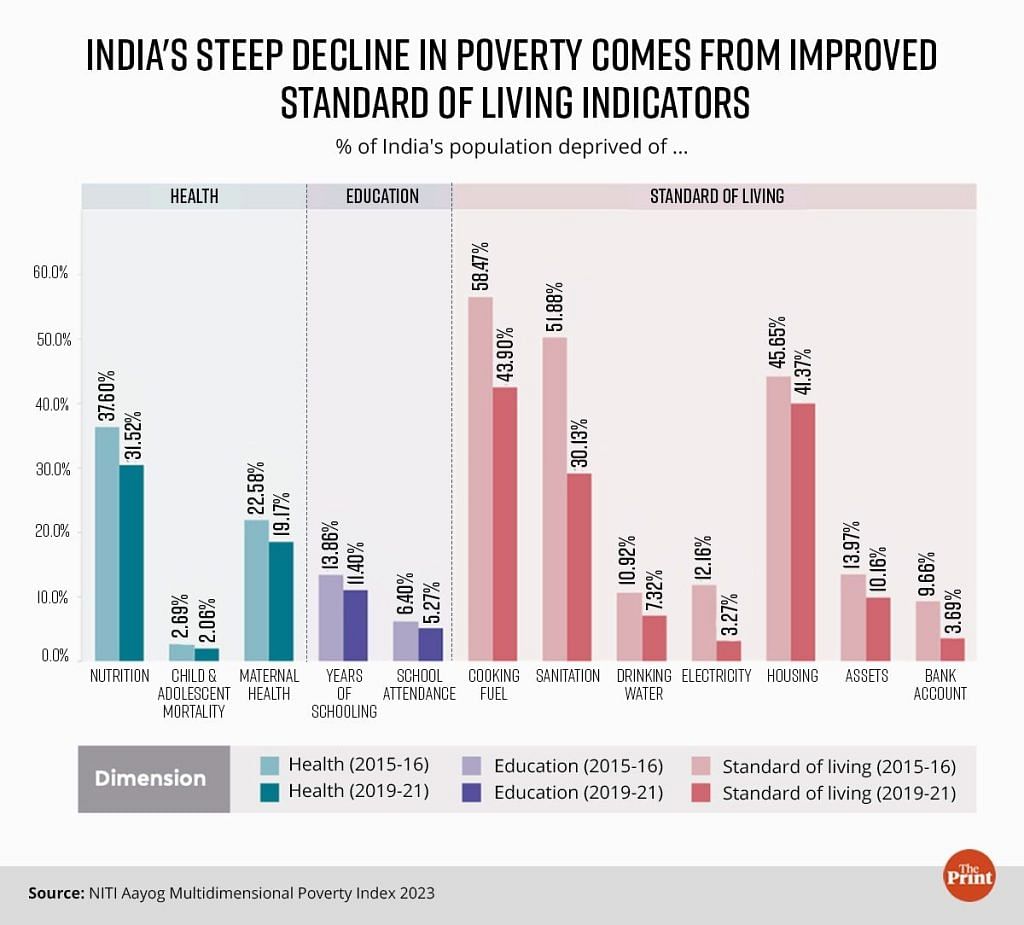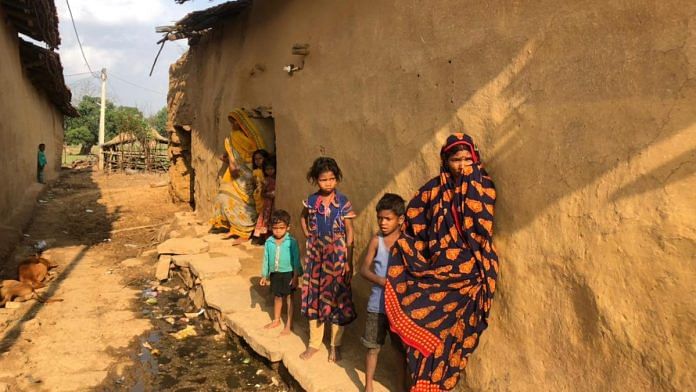New Delhi: The number of states with less than 10 per cent people living in multidimensional poverty doubled in the five years between 2016 and 2021, shows the latest report on poverty from government think tank NITI Ayog, released Monday.
Titled ‘National Multidimensional Poverty Index: A Progress of Review 2023’, the report examines three broad indicators of multidimensional poverty — health, education, and standard of living, each comprising various sub-indicators.
Rather than employing a standard income-based approach, it uses statistics from the National Family Health Survey (NFHS) to capture the various dimensions of poverty in India.
According to the report, in 2015-16 (NFHS-4), only seven states had less than 10 per cent of their population living in multidimensional poverty — Mizoram, Himachal Pradesh, Punjab, Sikkim, Tamil Nadu, Goa, and Kerala.
However, in 2019-21 (NFHS-5), the list had doubled to include 14 states, with the seven new additions being Telangana, Andhra Pradesh, Haryana, Karnataka, Maharashtra, Manipur, and Uttarakhand.
All of these states saw a significant reduction in poverty headcount ratios. The percentage of people living under multidimensional poverty decreased from 13.18 per cent to 5.88 per cent in Telangana; from 11.77 per cent to 6.06 per cent in Andhra Pradesh; from 11.88 per cent to 7.07 per cent in Haryana; from 12.77 per cent to 7.8 percent in Karnataka; from 14.8 per cent to 7.81 per cent in Maharashtra, rom 16.96 to 8.1 per cent in Manipur; and from 17.67 per cent to 9.67 per cent in Uttarakhand.
Collectively, India has lifted approximately 13.5 crore people out of multidimensional poverty in the same period, the report said.
In 2015-16, one in four Indians (24.85 per cent) met the criteria for multidimensional poverty. By 2019-21, this percentage decreased to 14.96 per cent, or one in seven.

Notably, except for Bihar, no other state in India has more than one-third of its population living in multidimensional poverty.
Even here, the improvement has been remarkable. In 2015-16, over 51.89 per cent of Bihar’s population lived in multidimensional poverty. By 2019-21, the figure had dropped to 33.76 per cent.
In other words, while one out of every two persons in Bihar was living in multidimensional poverty in 2015-16, that number has now improved to one in three.
Similarly, Jharkhand reduced the percentage of people living under multidimensional poverty from 42 per cent in 2015-16 to 28.82 per cent in 2019-21, Uttar Pradesh saw a decline from 37.68 per cent to 22.93 per cent, and in Madhya Pradesh, multidimensional poverty dropped from 36.57 per cent to 20.63 per cent.
However, a further examination of the data suggests that poverty reduction is not equally represented in the three main indicators of standard of living, health, and education.
Also Read: Old data, changing methodology — why number of Indians under poverty line is a mystery
How did India reduce multidimensional poverty so fast?
The answer to how India achieved such rapid poverty reduction lies in the data about the seven standard-of-living sub-indicators— cooking fuel, sanitation, drinking water, housing, electricity, assets, and bank accounts— rather than in the indicators for health and education.
For instance, the NITI Aayog report shows that around 58 per cent of Indians were deprived of clean cooking fuel in 2015-16, but by 2019-2021, it was only 44 per cent.
Similarly, the percentage of individuals lacking adequate sanitation facilities dropped from 51.88 per cent to 30.13 per cent, electricity deprivation went from 12 per cent to 3.27 per cent, and the percentage of people lacking access to banking reduced from 9.66 per cent to 3.69 per cent.

However, when it comes to “generational indicators” like health and education, the reduction has not been so steep.
Within the health category, three sub-indicators — nutrition, child and adolescent mortality, and maternal health — showed only moderate improvement.
Nutrition deprivation decreased from 37 per cent to 31 per cent, maternal health deprivation improved from 22.5 per cent to 19.17 per cent, and child and adolescent mortality deprivation declined from 2.69 per cent to 2.06 per cent.
In terms of education, there has been a slight reduction in the percentage of people facing deprivation on the two sub-indicators. The first indicator is “years of schooling,” where a household is considered deprived if no member has completed at least six years of schooling. The second indicator is “school attendance,” which considers a household deprived if any school-age child does not attend school until completing class 8.
The percentage of people experiencing deprivation in years of schooling, has marginally decreased from 13 per cent in 2015-16 to 11.4 per cent in 2019-21. Additionally, school attendance deprivation has decreased from 6.4% in 2015-16 to 5.27 per cent in 2019-21.
The data from the NITI Aayog report mirrors the findings of the UNDP Global Multidimensional Poverty Index, which showed that more than a third of India’s poor were pushed out of multidimensional poverty between 2005 and 2021. As reported by ThePrint last week, experts had highlighted the significant role played by the improvement in standard of living indicators. They had also emphasised that without increased government spending on health and education, further poverty reduction would be unlikely.
(Edited by Asavari Singh)



